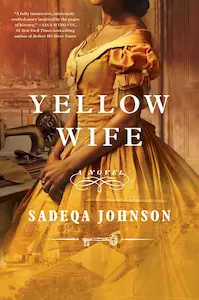Yellow Wife - Summary
Sadeqa Johnson

Introduction
In the historical fiction novel, “Yellow Wife” by Sadeqa Johnson, readers are transported to the antebellum South, where they witness the harrowing journey of a young slave girl named Pheby Delores Brown. Set in the mid-1850s, this gripping tale sheds light on the brutal realities of slavery and the resilience of the human spirit. Through vivid storytelling and compelling characters, Johnson explores themes of love, survival, and the quest for freedom. This book summary will delve into the key elements of “Yellow Wife” and provide examples and anecdotes from the novel to illustrate its power and impact.
Pheby’s Journey: A Glimpse into Slavery
The story begins on the tobacco plantation of the ambitious and cruel Randall Chesnut. Pheby, a biracial slave, serves as the personal maid to the plantation owner’s wife, Delly. Despite her privileged position, Pheby is not exempt from the horrors of slavery. Johnson vividly depicts the physical and emotional abuse endured by Pheby and her fellow slaves, highlighting the dehumanizing nature of their existence.
The Complexities of Identity
One of the central themes in “Yellow Wife” is the exploration of identity. Pheby’s mixed-race heritage places her in a unique position within the slave community. She is often referred to as the “yellow girl,” a term that both distinguishes her from her darker-skinned counterparts and subjects her to a different set of expectations and treatment. Johnson skillfully portrays the internal struggle Pheby faces as she grapples with her own sense of self and wrestles with the complexities of her identity.
The Power of Love and Loss
Throughout the novel, Pheby experiences both love and heartbreak. Her relationship with Essex, a fellow slave, provides solace and hope in the midst of their oppressive circumstances. Johnson masterfully captures the tenderness and passion between the two characters, allowing readers to feel the depth of their connection. However, their love is tested when Pheby is forced to make a devastating choice that will impact their future. The exploration of love and loss in “Yellow Wife” adds emotional depth to the narrative and further highlights the resilience of the human spirit.
The Quest for Freedom
As Pheby navigates the treacherous world of slavery, her ultimate goal is freedom. Johnson portrays her protagonist as a strong and determined young woman who refuses to accept her circumstances passively. Pheby’s relentless pursuit of freedom drives the narrative forward, creating a sense of urgency and tension throughout the novel. Through her character, Johnson sheds light on the indomitable spirit of those who fought for liberation during this dark period in history.
The Role of Female Resilience
“Yellow Wife” also explores the strength and resilience of women in the face of adversity. Pheby, along with other female characters, demonstrates unwavering courage and resourcefulness. They navigate the oppressive world of slavery with a combination of cunning, intelligence, and compassion. Johnson’s portrayal of these women challenges traditional narratives of victimhood and showcases the power of female resilience.
An Exploration of the Slave Trade
In addition to its focus on individual stories, “Yellow Wife” provides a broader examination of the slave trade itself. Johnson delves into the economic and political motivations behind the institution of slavery, shedding light on the systemic nature of oppression. Through her meticulous research and attention to historical detail, the author paints a vivid picture of the antebellum South and the brutal realities faced by enslaved individuals.
Themes of Betrayal and Redemption
Betrayal and redemption are recurring themes in “Yellow Wife.” Pheby experiences both firsthand as she encounters individuals who are willing to sacrifice her well-being for their own gain. These betrayals serve as catalysts for Pheby’s growth and transformation throughout the novel. Johnson skillfully weaves these themes into the narrative, adding layers of complexity to the story.
The Strength of Community
Despite the horrors they face, the enslaved characters in “Yellow Wife” find solace and support in their community. Johnson portrays the bonds of friendship and kinship that develop among the slaves, offering a glimmer of hope amidst the darkness. These relationships provide a source of strength and resilience, reminding readers of the power of unity in the face of oppression.
Conclusion
“Yellow Wife” by Sadeqa Johnson is a powerful and poignant novel that shines a light on the brutal realities of slavery while celebrating the strength and resilience of the human spirit. Through the compelling story of Pheby Delores Brown, Johnson explores themes of identity, love, and the quest for freedom. With its vivid storytelling and well-developed characters, this book offers readers a thought-provoking and emotionally impactful journey through history. “Yellow Wife” serves as a reminder of the importance of confronting and understanding the past to shape a more just and compassionate future.